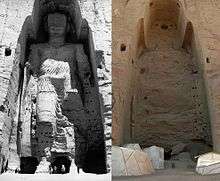Afghan art

Afghan art has spanned many centuries. One of the most significant periods is the Gandharan art made between the 1st and 7th centuries developing out of Greco-Buddhist art. With the arrival of Islam, modern Afghanistan was for long periods part of Persian states, and its art was often an important part of Persian art and Islamic art in general.
Since the 1900s, the nation began to use Western techniques in art. Afghanistan's art in many media was originally almost entirely done by men, although women were greatly involved in other media, but recently women are entering the arts programs at Kabul University. Art is largely centered at the National Museum of Afghanistan, the National Gallery of Afghanistan and the National Archives of Afghanistan in Kabul. There are a number of art schools in the country. The Center for Contemporary Arts Afghanistan (CCAA) in Kabul provides young people an opportunity to learn contemporary painting..
Metalwork
A collection of over 20,600 gold ornaments, some of them dating back to the Bronze Age, was discovered in Afghanistan in the late 1970s. Known as the Bactrian Hoard, these coins, necklaces and other pieces of jewelry were found in burial mounts in Sheberghan in Jowzjan Province. They have been displayed in museums in the US and Europe.[1]
Greco-Buddhist Art
Greco-Buddhist art was prevalent in Afghanistan from the 4th Century BCE to around the 7th Century CE due to the Islamic Conquest. Many of these art forms have been found in the archaeological site of Hadda, Afghanistan.[2] The 6th-century Buddhas of Bamiyan are a well-known example of Gandhara art from this period. They were destroyed by the Taliban in 2001.

Islamic Art
After the Islamic conquest of Afghanistan, Afghan art changed dramatically from previous Greco-Buddhist works, due to the adoption of Islam. Afghan local materials such as lapis lazuli were adapted for use in Islamic Art. Mosques built in Afghanistan and in the Arab world are built with elaborate tiling styles. Many of these styles were influenced from Chinese ceramics [3] Afghanistan served as a conduit for introduction to these Chinese ceramic styles and techniques due to its strategic location on the Silk Road.
Performance Art
Buz-baz is a form of musical puppetry found in Afghanistan. The puppeteer manipulates a markhor marionette while simultaneously playing a dambura.
Fine Art
Afghanistan fine art was protected during the Taliban times by art masters at the Senai Art School. The professors often hid "un-Islamic" paintings from the Taliban when they would visit and inspect. Other artists used water color over oil paintings to conceal faces and images not approved by the Taliban. Since 2002, the Afghan fine art master painters have been able to conduct many more exhibitions within Central Asia and Europe. Their oil and water color paintings are often found in the realism style, as that is what most Afghans prefer.[4]
Modern Art
Since the fall of the Taliban in 2001, contemporary art has seen a resurgence in Afghanistan. Beginning in 2009, international funding for the arts has flowed into Afghanistan from the United States and Europe.[5] In 2012, Kabul-based artist Aman Mojadidi curated a 2012 Documenta exhibit in Kabul which showcased 12 contemporary Afghan artists whose work includes digital photography, textiles, abstract painting, filmmaking and mixed media.[5]
References
- ↑ "Afghanistan: Hidden Treasures from the National Museum, Kabul" Archived February 8, 2005, at the Wayback Machine.
- ↑ See image
- ↑ Canby, 120-123, and see index; Jones & Mitchell, 206-211
- ↑ Afghanistan Art History Archived January 5, 2012, at the Wayback Machine.,
- 1 2 Gerner, Martin (28 June 2012). "Solutions Don't Always Come from Elsewhere". Qantara.de. Retrieved 2 January 2013.